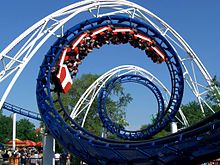- Corkscrew (Cedar Point)
-
Corkscrew 
The final inversion on Corkscrew Location Cedar Point Coordinates 41°29′1″N 82°41′7.25″W / 41.48361°N 82.6853472°WCoordinates: 41°29′1″N 82°41′7.25″W / 41.48361°N 82.6853472°W Status Operating Opened May 15, 1976 Cost $1,750,000 USD Type Steel Manufacturer Arrow Dynamics Designer Ron Toomer Model Looping corkscrew roller coaster Track layout Out and Back Height 85 ft (26 m) Drop 65 ft (20 m) Length 2,050 ft (620 m) Max speed 48 mph (77 km/h) Inversions 3 Duration 2:00 Capacity 1800 riders per hour Height restriction 4 ft 0 in (122 cm) Corkscrew at RCDB Pictures of Corkscrew at RCDB  Amusement Parks Portal
Amusement Parks PortalCorkscrew is a roller coaster at the Cedar Point amusement park in Sandusky, Ohio. When built in 1976, it was the first roller coaster in the world with 3 inversions.
The ride is located on the midway directly across from Top Thrill Dragster, between Power Tower and Magnum XL-200. Corkscrew was the first coaster to have inversions featuring a walkway underneath. It consists of an elevated station that houses the patriotic cars, made in combinations of red & white, white & blue, and blue & white. They are designed in this manner because they debuted in 1976, the U.S. Bicentennial.
General
Riders leave the station when the ride operator releases the pneumatic station brakes. The slight decline of the station allows the car to roll out down a small drop and around a declining 180 degree curve until the train reaches the chain lift. The lift operates at or near a speed of 5 mph (8.0 km/h) and ascends, at a 30 degree angle, an 85 foot (26 m) lift hill; then riders are dropped 65 feet (20 m) at a 45 degree angle, gaining speed up to 48 m.p.h (77 km/h). The next element is a bunny hop, so named for the quick rise and fall. It then goes through a vertical loop (Corkscrew opened only 8 days after the first modern coaster to feature a vertical loop, Revolution at Six Flags Magic Mountain). It then coasts up a slight incline and curves around a 180 degree slight decline, heading into the twin corkscrews over the midway of the park. In the "eye" of the corkscrews, it is traveling at 38 mph (61 km/h). It completes two corkscrew loops, comes through trim and block brakes, and coasts back into the station.
The ride is 2,050 feet (620 m) long, consisting of blue tubular steel track with a 48-inch (1,200 mm) separation between tubes, built on 5 acres (20,000 m2), rides for 1 minute and 40 seconds, and has three 24-passenger trains. Almost daily, a train is transferred off the track once ridership reaches a point that permits two-train operation with little or no waiting in line. A different train is cycled off each day. The ride was designed by Ron Toomer and built by Arrow Dynamics, and the same can be said for many thrill rides at the park, from the classic Cedar Creek Mine Ride to the 200+ foot Magnum XL-200. The total cost of construction was $1.75 million, and the ride has had over 30 million total riders since opening in May 1976.
References
External links
Preceded by
CorkscrewFirst coaster with 3 inversions
May 1976–March 1980Succeeded by
The DemonRoller coasters at Cedar Point Operating: Blue Streak · Cedar Creek Mine Ride · Corkscrew · Disaster Transport · Gemini · Iron Dragon · Jr. Gemini · Magnum XL-200 · Mantis · Maverick · Mean Streak · Millennium Force · Raptor · Top Thrill Dragster · Wicked Twister · WildCat · Woodstock ExpressFormer: Broadway Trip · Cyclone · Dip the Dips Scenic Railway · High Frolics · Jumbo Jet · Kiddieland Roller Coaster · Leap the Dips · Racer · Scamper · Switchback Railway · Three-Way Figure Eight Roller Toboggan · Wild Mouse · WildcatCategories:- Steel roller coasters
- Arrow Dynamics roller coasters
- Roller coasters introduced in 1976
- Cedar Point
Wikimedia Foundation. 2010.
